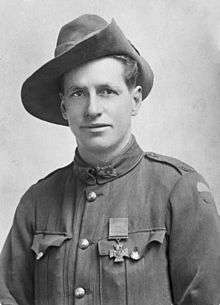James Park Woods
| James Park Woods | |
|---|---|
 Private James Woods c.1918–19 | |
| Born |
4 January 1886 Two Wells, South Australia |
| Died |
18 January 1963 (aged 77) Nedlands, Western Australia |
| Allegiance | Australia |
| Service/branch | Australian Imperial Force |
| Years of service | 1916–19 |
| Rank | Private |
| Unit | 48th Battalion |
| Battles/wars |
First World War |
| Awards | Victoria Cross |
| Other work | Vigneron |
James Park Woods, VC (4 January 1886 – 18 January 1963) was an Australian recipient of the Victoria Cross, the highest award for gallantry in the face of the enemy that can be awarded to British and Commonwealth forces.
Early life
James Park Woods, the son of a blacksmith, was born at Two Wells in South Australia on 4 January 1886. He was raised by a stepsister after the death of his parents and, after completing his schooling, worked on an orchard alongside his brothers. Of short stature (163 cm or 5 ft 4 ins), an attempt to enlist in the Australian Imperial Force (AIF) in 1914 failed. He and a brother, Will Woods, moved to Western Australia and for the next two years worked in cartage and fencing before taking up vineyard work. After further attempts to join the AIF failed, on 29 September 1916, after height restrictions were lowered, he successfully enlisted.[1]
Military career
Woods embarked for the Western Front from Fremantle on 23 December 1916 as a reinforcement for 48th Battalion, with the rank of private. He arrived in England in February 1917 but spent most of the next few months in hospital due to illness and did not join the battalion until September 1917. He continued to struggle with his health and had further periods in hospital, firstly in January 1918 due to pericarditis and later, in July 1918, with dysentery.[2]
By September 1918, the Allies were in the midst of the Hundred Days Offensive. As part of 12th Brigade, 4th Division, the 48th Battalion was advancing near Le Verguier, north-west of St. Quentin when Woods was part of a patrol scouting the location of flanking units. The patrol of four men identified a strongly defended German position with good fields of fire. While an attack in force on the position was being organised, Woods decided to lead his patrol against the German defenders. His foray was successful but then the Australians had to defend several counterattacks until reinforcements arrived. For his work, Woods was recommended for the Victoria Cross (VC).[3] The citation was published on Christmas Eve 1918, and read:
For conspicuous bravery and devotion to duty near Le Verguier, north-west of St. Quentin, on 18th September, 1918, when, with a weak patrol, he attacked and captured a very formidable enemy post, and subsequently, with two comrades, held the same against heavy enemy counterattacks. Although exposed to heavy fire of all descriptions, he fearlessly jumped on the parapet and opened fire on the attacking enemy, inflicting severe casualties. He kept up his fire and held up the enemy until help arrived, and throughout the operations displayed a splendid example of valour, determination and initiative.— The London Gazette, 24 December 1918[4]
Woods' VC was the first to be awarded to a member of 48th Battalion.[3] He survived the war, arrived back in Fremantle aboard the troop ship SS Königin Luise in August 1919, and was discharged from the AIF the following month.[2][5]
Later life
On his return to civilian life, Woods operated a vineyard and orchard in Swan Valley, Western Australia. Married in 1921 to Olive Wilson, the couple had seven children. He still suffered from poor health and in 1937 retired on a full pension. In his retirement he was involved with the Returned Sailors', Soldiers' and Airmen's Imperial League of Australia and in 1956, went to England to attend the VC centenary. [1]
Woods died on 18 January 1963 in the Repatriation General Hospital, Hollywood in Nedlands and is buried in Karrakatta Cemetery. He was survived by his wife and six children; his oldest son was killed in action during the Second World War.[1] A ward at the Repatriation General Hospital, now known as the Hollywood Private Hospital, is named in his honour.[6] His Victoria Cross is held by the Australian War Memorial, in Canberra.[7]
Notes
- 1 2 3 Higgins 1990, p. 564.
- 1 2 "James Park Woods". The AIF Project. Retrieved 16 September 2014.
- 1 2 Wigmore 1963, pp. 168–170.
- ↑ The London Gazette: (Supplement) no. 31082. p. 15119. 24 December 1918. Retrieved 2014-09-16.
- ↑ Jarrett, Ian (21 April 2014). "Tale of two ships". The West Australian. Retrieved 31 December 2015.
- ↑ "Our Hospital: A History of Caring". Hollywood Private Hospital. Retrieved 16 September 2014.
- ↑ "Victoria Cross". Australian War Memorial. Retrieved 14 September 2014.
References
- Higgins, Matthew (1990). "Woods, James Park (1886–1963)". Australian Dictionary of Biography. Volume 12. National Centre of Biography, Australian National University. p. 564.
- Wigmore, Lionel (1963). They Dared Mightily. Canberra: Australian War Memorial.